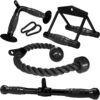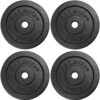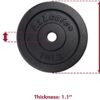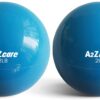Can You Gain Muscle While Losing Weight?
For many people trying to lose weight, their body goal comes with a buddy: muscle gain.

It’s not as simple as aesthetics. Healthy levels of muscle mass are vital to overall health, especially as you lose weight. Lean muscle supports your strength, energy levels, mobility, heart, and insulin health. It’s linked to a longer life span and plays a major role in your basal metabolic rate.
The problem is that most of the time when people succeed at their weight-loss goals, they wind up losing muscle. Some even find their body fat percentages increasing.
Why? Because when following a caloric deficit – consuming fewer calories than you burn every day – you tell your body to break down, rather than build, explains Marie A. Spano, an Atlanta-based board-certified sports dietitian, and certified strength and conditioning specialist. This caloric deficit is mandatory for breaking down and losing fat.
But a caloric surplus – consuming more calories than you burn every day – is what tells your body to build … and to build lean muscle.
Strategies to Build Muscle
So, how can you build muscle while still losing fat when biology is working completely against you? By following these six expert-approved strategies.
1. Keep your caloric deficit small.
With caloric deficits driving weight loss and surpluses stimulating muscle gain, a happy medium is ideal for “recomposition,” or decreasing body fat while increasing lean muscle mass.
For instance, in one 2016 Obesity study, when people drastically cut calories for 12 weeks, they lost 8.8% of their total-body muscle. When people cut conservatively, they only lost 1.3% of their muscle.
The smaller your caloric deficit, the less muscle will break down as you lose weight – and the greater your likelihood of being able to actively build muscle, explains Jim White, registered dietitian, exercise physiologist, and owner of Jim White Fitness & Nutrition Studios in Virginia. Previous research shows that exercisers can build substantial muscle if they keep a very small caloric deficit.
Your goal? Lose no more than 1 to 2 pounds per week, according to White. While every person will need to cut calories and/or increase their activity levels slightly differently to lose weight at this rate, reducing caloric intake by 500 calories per day is a good place to start. To make greater muscle gains, cut even less.
2. Be patient.
This might be the hardest tip of all, but it’s important to keep in mind. That’s because, while you may notice yourself making great gains to start with, they will naturally slow over time.
“It becomes progressively more difficult to increase muscle while losing fat as you become more trained and get leaner,” says researcher Brad Schoenfeld, a certified strength and conditioning specialist and former board member for the National Strength and Conditioning Association.
It’s just how the human body works: The more excess fat we have to lose, the easier it is to lose 5 pounds of fat. (This is especially true when maintaining a very small caloric deficit.)
The more muscle we have to gain, the easier it is to gain 5 pounds of muscle. As you get closer to your goal, expect to see more subtle changes in your fat and muscle levels, and don’t get discouraged.
3. Eat 25-plus grams of protein four times per day.
Your muscles use the protein you eat to grow bigger or stronger. When cutting calories, your body’s muscles may be less sensitive to the protein you eat, Spano says.
Hence why, in one study published in The American Journal of Clinical Nutrition, when exercising men followed a low-calorie diet that was high in protein for four weeks, they lost 10.56 pounds of fat while gaining 2.64 pounds of lean muscle. Meanwhile, those who followed a diet with the same amount of calories, but less protein, only lost 7.7 pounds of fat and gained less than a quarter-pound of muscle.
“In addition, this protein intake should be spaced out evenly throughout the day,” Spano says. This keeps your muscles fed with a steady stream of building blocks.
In fact, a 2018 review in the Journal of the International Society of Sports Nutrition concluded that for optimal muscle growth, people should consume between 0.4 and 0.55 grams of protein per kilogram of their body weight four times per day.
For a 180-pound adult, that equals four meals of 33 to 45 grams of protein. Other research recommends 25 to 35 grams of protein at every meal for most adults – and slightly more for vegetarians and vegans.
4. Do compound strength exercises at least three times per week.
“We need to include at least two days of weight training a week to maintain existing muscle mass and three or more times a week to build muscle,” White says. And in one Harvard School of Public Health study of 10,500 adults, researchers found that strength training doesn’t just build muscle – it also helps reduce abdominal fat levels.
The most effective exercises, for both fat loss and muscle gain, are compound – meaning they work for multiple muscle groups at once. Examples include squats, chest presses, and rows.
Focus on making these moves the top priority of your weekly workout routine, and then you can start to think about adding the right cardio workouts to your routine. (More on them next.)
5. Use cardio for recovery.
Cardio isn’t the most effective way to build (or maintain) muscle when you’re in a caloric deficit.
Fortunately, it is a great tool to help you recover from your strength-training workouts so that, in the end, you maintain and build the most muscle possible. Low-intensity cardio like walking, jogging, and gentle cycling or swimming increase blood flow through the body to get oxygen and other nutrients to your muscle cells, explains Dean Somerset, an Alberta-based kinesiologist.
6.Do HIIT sparingly.
As a last add-in to your workout plan, try high-intensity interval exercises such as repeated sprints on the treadmill, elliptical, or bike.
These workouts can help burn calories and reduce body fat while still building muscle, White says. However, you’re best served using them only on occasion, like once or twice per week. Strength training should still be your workout focus, and overdoing it on high-intensity cardio can overstress your muscles – making them much less likely to grow.
The bottom line: Yes, you can gain muscle while losing weight. Focus on both fueling and training your muscles while keeping your caloric deficit small. Make sustainable changes that you can stick with over the long term – both fat loss and muscle gain take time.
Source: health.usnews











